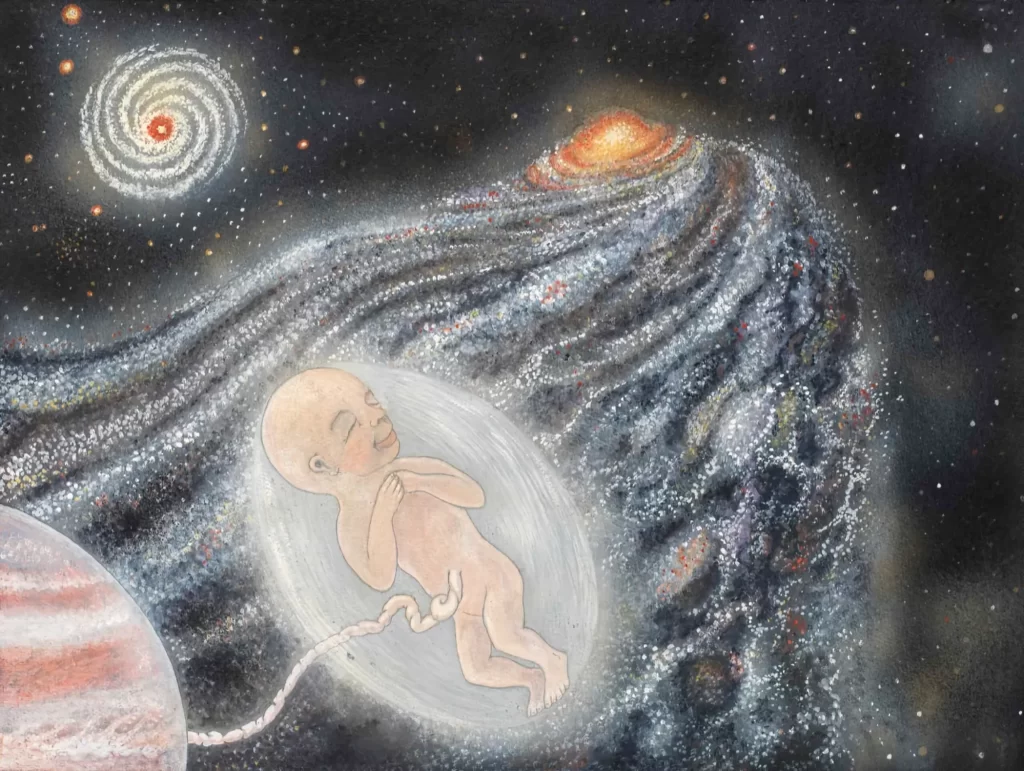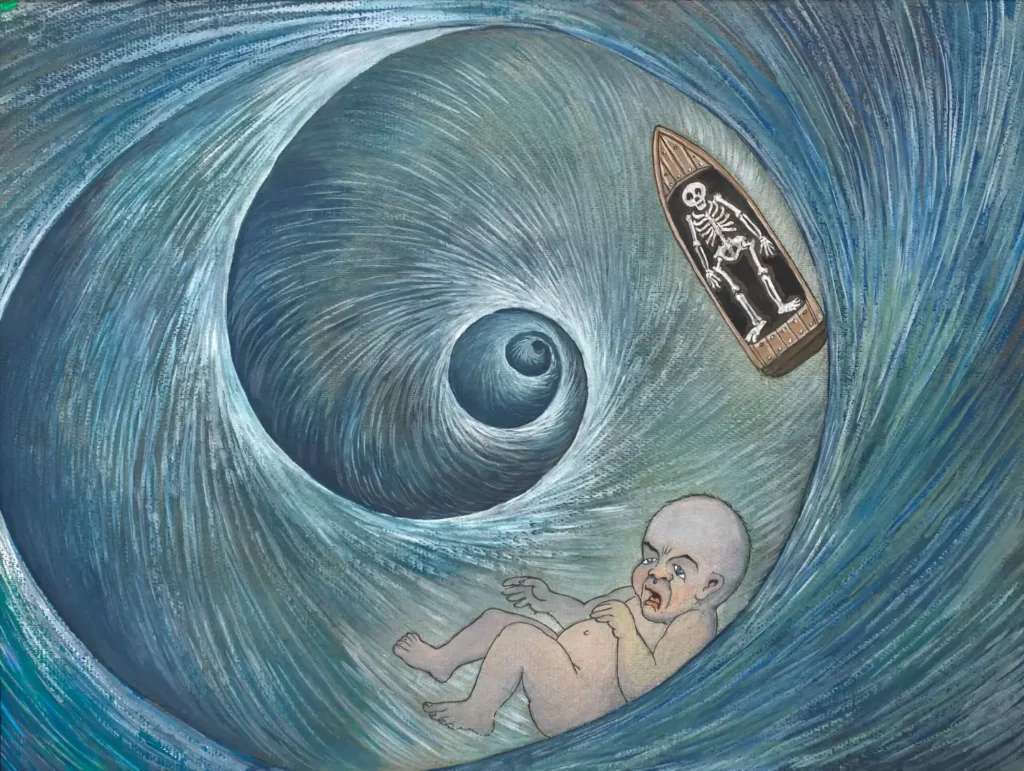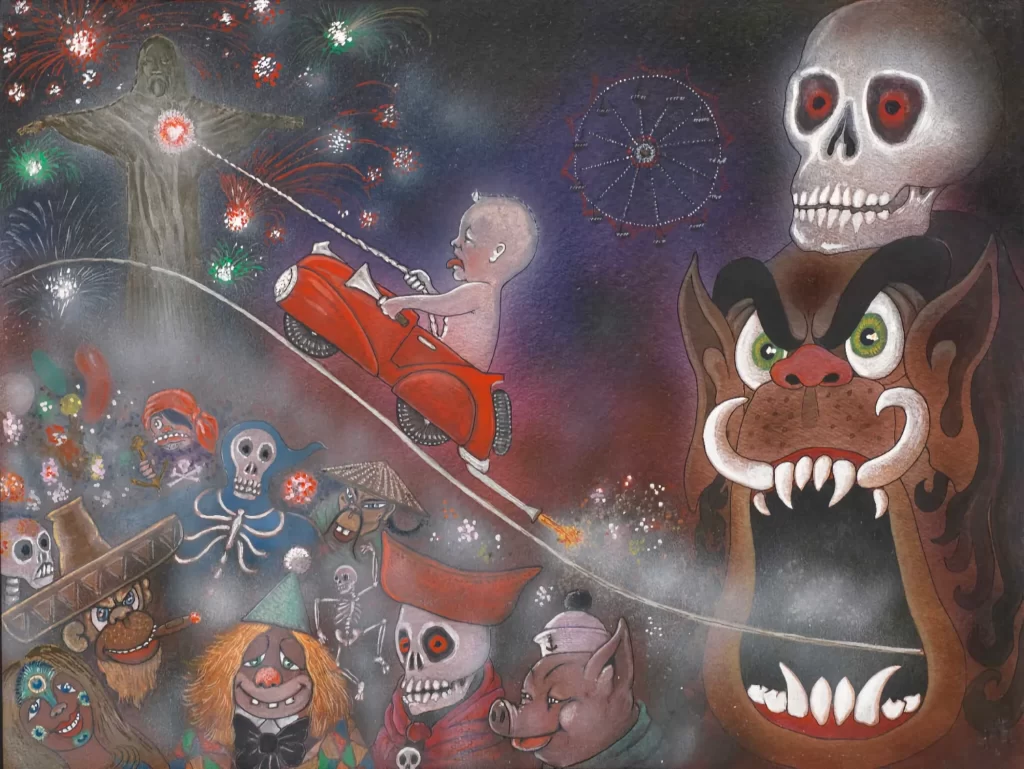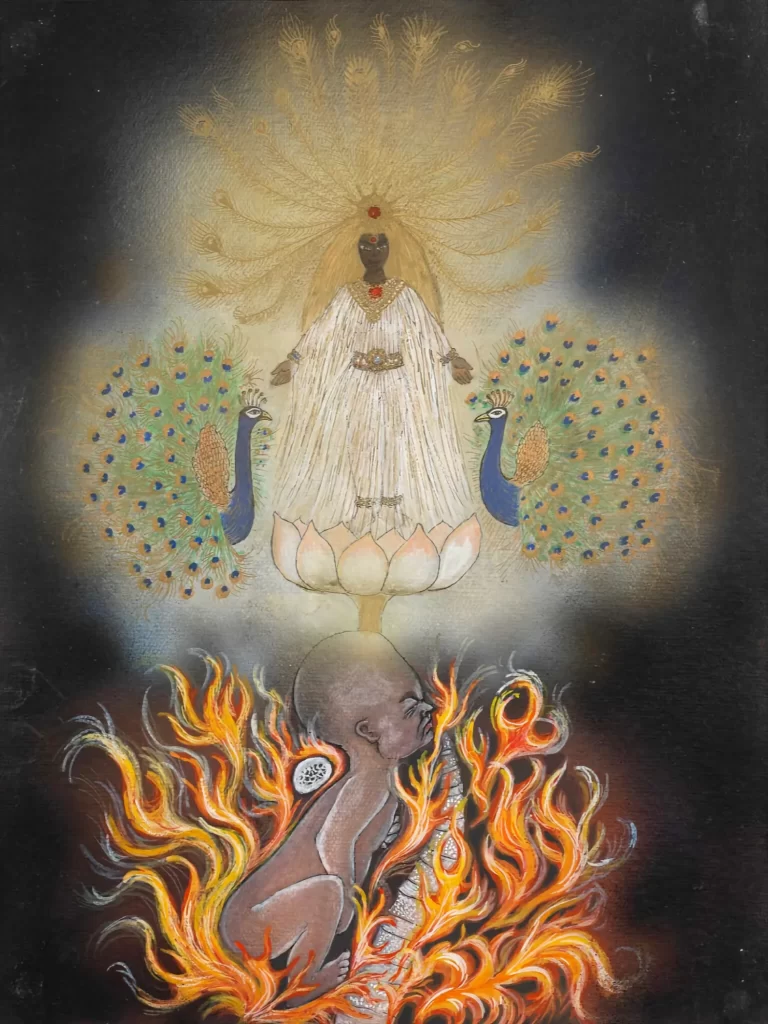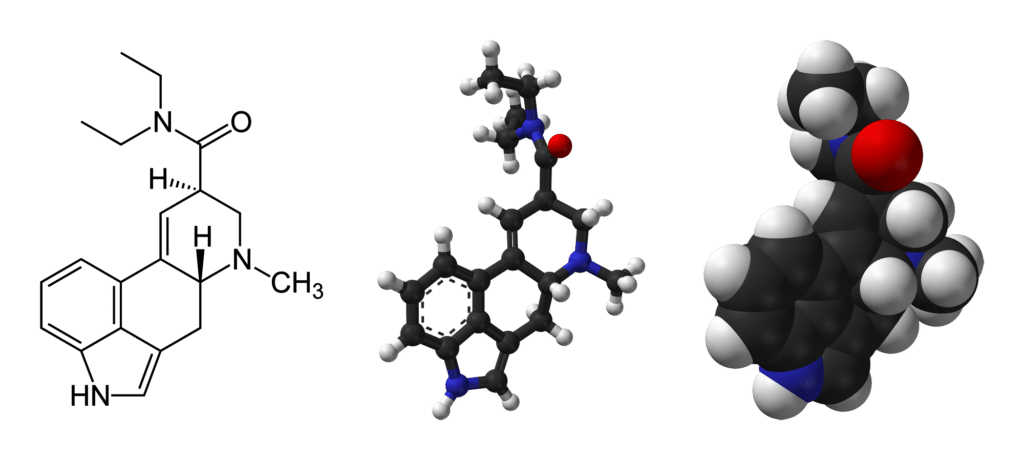Theoretical Framework
CONTENTS
The Perinatal Domain
It was Grof’s consistent observation that any COEX system that starts manifesting itself in the process of holotropic therapy (or psychedelic therapy, or potentially any other form of experiential therapy capable of reaching pre-biographical content) will sooner or later begin to reveal its roots as embedded in the perinatal domain. It is at this time that the healing process really starts to take off.
Psychospiritual Death and Rebirth
We have already briefly mentioned that, as we extend our exploration into the perinatal realm, we are setting ourselves up to undergo a process perhaps best described as psychospiritual death and rebirth. Sometimes we may also encounter the term ego death.[13] When we search for these terms online, we usually get lofty descriptions e.g. “complete loss of subjective self-identity”, or “an imageless experience in which there is no sense of personal identity”, or even something like “the obliteration of the Self”, etc. Often, confusion between the concepts of ego death and enlightenment is also encountered. In any case, there seems to be no shortage of people who feel compelled to describe this process, explain it or otherwise comment on it, which only shows how fundamental and universally important it is to a human being’s life.
What we see in the practice of Holotropic Breathwork is that people usually don’t encounter ego death as a single, distinct, definite event, but rather experience it multiple times, getting an opportunity to see and appreciate it through different optics and from different angles, at various levels of depth of insight. This often happens over the course of many years. It may occur in a single person’s life on one occasion as a series of subtle intimations hinting at various aspects of the life-death dyad. At another time, it may seem as if the process of dying and being born is constantly manifested in everything around them. On yet another occasion, that same person may undergo a radical, once-in-a-lifetime, full-blown experience of a total ego dissolution. This may occur e.g. during a high-dose psychedelic session, with full awareness of the dying process and the subsequently resulting clear memory of the moment of the ultimate “letting go”. But these are mere examples. In practice, there really is no limit to the ways one may experience the universal Mystery of Death and Rebirth. So, it is pretty much up to each of us to decide whether we wish to include in our understanding of the ego death the sum of all its possible manifestations, in their many nuances, occurring on various levels and in diverse areas of our lived experience, or if we wish to reserve the term only for a single, perhaps exceptionally powerful instance of it.
Basic Perinatal Matrices – BPM I-IV
Now, for the thoughtful holotropic practitioner, it will be a good idea to further break down the perinatal domain into its subcategories, as the knowledge of these may help to stabilize and integrate the process of self-exploration later on, in its more advanced stages.
Grof recognized a distinctive pattern in how the perinatal content tends to reveal itself in the holotropic process. There are four qualitatively distinct subdomains in Grof’s model of the perinatal. Grof calls these four sub-domains Basic Perinatal Matrices (or BPM). These matrices form a sequence of experiential content that occurs over the course of our intrauterine development (or, in other words, pregnancy). This nine-month-long period happens to be of cardinal importance in shaping the character of the entire subsequent life of every individual. Once we succeed in directly contacting this early period of our development, we will begin to intuitively understand how it vitally informs every aspect of our postnatal life.
Let’s take them one after the other…
BPM I
The whole process of psychospiritual death and rebirth, as we undergo it during the very early stages of our biological life, begins in the first basic perinatal matrix. This is the experiential world of the intrauterine life, of what Grof sometimes called the amniotic universe.[14] The fetus is unaware of any boundaries whatsoever, does not differentiate between inner and outer, its own organism and the maternal organism. There is a genuine unity of the fetus and its surrounding environment.
If everything goes well and undisturbed during this early period, then people who re-enter this experiential realm later in the holotropic process often describe experiences of “vast regions with no boundaries or limits, […] identify with galaxies, interstellar space, or the entire cosmos. A related experience is that of floating in the sea, identifying with various aquatic animals, such as fish, jellyfish, dolphins, or whales, or even becoming the ocean. This seems to reflect the fact that the fetus is essentially an aquatic creature. Positive intrauterine experiences can also be associated with archetypal visions of Mother Nature, safe, beautiful, and unconditionally nourishing like a “good womb”. We can envision fruit-bearing orchards, fields of ripe corn, agricultural terraces in the Andes, or unspoiled Polynesian islands. Mythological images from the collective unconscious that often appear in this context portray various celestial realms and paradises as they are described in mythologies of different cultures.”[15]
Sometimes, however, even intrauterine life does not progress ideally, with all kinds of disturbances occurring. This would include various instances of accidents, illnesses of the mother, an autoimmune reaction of the maternal organism, drug abuse, emotional distress, etc. When we are reliving these experiences of what could be called the “bad womb”, we “have a sense of dark and ominous threat and often feel that we are being poisoned. We might see images that portray polluted waters and toxic dumps. This reflects the fact that many prenatal disturbances are caused by toxic changes in the body of the pregnant mother. Sequences of this kind can be associated with archetypal visions of frightening demonic entities or with a sense of insidious all-pervading evil. Those of us who relive episodes of more violent interference with prenatal existence, such as an imminent miscarriage or attempted abortion, usually experience some form of universal threat or bloody apocalyptic visions of the end of the world.”[16]
As soon as the first contractions occur, the fetus moves into the next stage…
BPM II
The second basic perinatal matrix is where things start getting dramatic. The fetus, until now experiencing itself as one with the maternal organism, suddenly finds itself being seriously threatened by the beginning contractions. Its entire environment, indeed the whole cosmos, turns hostile and the situation is now getting progressively worse. The mechanical pressures are increasingly terrifying, and, worse still, the fetus begins to experience periodically returning states of suffocation, as the flow of oxygenized blood through the vascular tissue of the placenta becomes obstructed during the contractions. The entire “known universe” collapses on the fetus, unleashing actual Hell. The cervix has not yet opened, the pressures are increasingly unbearable, the situation seems fatal.
BPM II – The Maelström and other common manifestations
Grof observes that, when we are reliving these experiences in holotropic (or psychedelic) therapy, “we typically feel that we are being sucked into a gigantic whirlpool or swallowed by some mythic beast. We might also experience that the entire world or cosmos is being engulfed. This can be associated with images of devouring or entangling archetypal monsters, such as leviathans, dragons, whales, giant snakes, tarantulas, or octopuses. The sense of overwhelming vital threat can lead to intense anxiety and general mistrust bordering on paranoia. Another experiential variety of the […] second matrix is the theme of descending into the depths of the underworld, the realm of death, or hell. …
… It is only natural that someone facing this aspect of the psyche would feel a great reluctance to confront it. Going deeper into this experience seems like meeting eternal damnation. Yet, the fastest way of terminating this unbearable state is surrendering to it completely and accepting it. […] It is an important stage of spiritual opening that can have an immensely purging and liberating effect.”[17]
BPM III
When the claustrophobic hell of BPM II reaches its full manifestation and we finally surrender to it, the process reaches a turning point. The cervix opens and that constitutes a decisive shift in the situation. Although the severity of the mechanical pressures of the contractions continues, or even keeps increasing and the threat of annihilation is still imminent, there nonetheless is an important qualitative change – the situation is not hopeless anymore, because there is now a way out. It is a transition from Hell, to “Hell with a perspective”. The third matrix is a fight for life. It involves hurting and being hurt, both as a result of the desperate struggle to be born. It is marked by a peculiar, highly emotionally charged mixture of huge violent impulses directed both towards the environment as well as ourselves, intense anxiety and a surreal blend of bizarre imagery and sexual excitement.
A terrifying, phantasmagoric ride through BPM III
BPM III “is an extremely rich and complex experiential pattern. Besides the actual realistic reliving of different aspects of the struggle in the birth canal, it involves a wide variety of imagery drawn from history, nature, and archetypal realms. The most important of these are the atmosphere of titanic fight, aggressive and sadomasochistic sequences, experiences of deviant sexuality, demonic episodes, scatological involvement, and encounter with fire. …
… The Titanic aspect of BPM III is quite understandable in view of the enormity of the forces operating in the final stage of childbirth. When we encounter this facet of the third matrix, we experience streams of energy of overwhelming intensity, rushing through the body and building up to explosive discharges. …
… Aggressive and sadomasochistic aspects of this matrix reflect the biological fury of the organism whose survival is threatened by suffocation, as well as the introjected destructive onslaught of the uterine contractions. …
… Sexual experiences that occur in the context of BPM III are characterized by enormous intensity of the sexual drive, by their mechanical and unselective quality, and their exploitative, pornographic, or deviant nature. They depict scenes from red-light districts and from the sexual underground, extravagant erotic practices, and sadomasochistic sequences. …”[18]
As the flaming agony of the final stages of BPM III runs its course, our mind finally opens to the great experiential resolution of the whole death and rebirth process: we become a newborn. Dying and being born, fear and ecstasy, defeat and victory, confusion and order, futility and purpose – they are all now parts of one perfect whole.[19]
BPM IV
The fourth matrix is the matrix of reunion with the maternal organism. It is the final destination, reached after a long and hard struggle. It is the Home to which we have returned after a difficult and dangerous adventure. It is the same Home from which we earlier embarked on our journey, yet, we ourselves are not the same anymore. Everything old and corrupt has been burned in the fierce blaze of the final stages of BPM III, and here we are — a genuinely new entity, a self-aware individual with a unique creative potential, full of divine light, born into an entirely new world. This is transcendence!
BPM IV — Transcendence
Let us conclude this section on Basic Perinatal Matrices with one last excerpt from Grof’s Psychology of the Future:
“The ‘dying’ and the agony during the struggle for rebirth reflect the actual pain and vital threat of the biological birth process. However, the ego death that precedes rebirth is the death of our old concepts of who we are and what the world is like, which were forged by the traumatic imprint of birth and are maintained by the memory of this situation that stays alive in our unconscious.
As we are clearing these old programs by letting them emerge into consciousness, they are losing their emotional charge and are, in a sense, dying. But we are so identified with them that approaching the moment of the ego death feels like the end of our existence, or even like the end of the world. As frightening as this process is, it is actually very healing and transforming. …
… What is actually dying in this process is the false ego that, up to this point in our life, we have mistaken for our true self.”

